ISSN 2307–3489 (Print), ІSSN
2307–6666 (Online)
Наука та прогрес
транспорту. Вісник
Дніпропетровського
національного університету залізничного
транспорту, 2018, №
6 (78)
рухомий
склад залізниць і тяга поїздіВ
рухомий
склад залізниць і тяга поїзді
UDC
656.223.2
D. V. LOMOTKO1*,
D. V. ARSENENKO2,
N. A. NOSKO3,
O. V. KOVALOVA4
1*Dep. «Transport
System and Logistic», Ukrainian State University
of Railway
Transport, Feuerbach Sq., 7, Kharkiv, Ukraine, 61050,
tel. +38 (057)
730 19 55, e-mail
den@kart.edu.ua,
ORCID 0000-0002-7624-2925
2Dep.
«Transport System and Logistic», Ukrainian State University
of
Railway Transport, Feuerbach Sq., 7, Kharkiv, Ukraine, 61050,
tel.
+38 (057) 730 19 55, e-mail
TSL@kart.edu.ua,
ORCID 0000-0001-7757-8706
3Dep.
«Transport System and Logistic», Ukrainian State University
of
Railway Transport, Feuerbach Sq., 7, Kharkiv, Ukraine, 61050,
tel.
+38 (057) 730 19 55, e-mail
TSL@kart.edu.ua,
ORCID 0000-0002-4741-5890
4Dep.
«Operation Transportation Processes», Ukrainian State University
of
Railway Transport, Feuerbach Sq., 7, Kharkiv, Ukraine, 61050,
tel.
+38 (057) 730 10 85, e-mail
kovalova.uvkr@kart.edu.ua,
ORCID 0000-0001-5342-0795
FORMALIZATION OF ROLLING STOCK
DISTRIBUTION PROCESSES
BY USING
DYNAMIC MODEL
Purpose. The scientific article formalized process improving
the efficiency of rolling stock distribution in railways for loading
goods by introducing concentration of loading at the terminal by
using a dynamic model. Methodology. According to the
experience, the distribution of rolling stock by the infrastructure
operator is a complex process. The questions on transport
expeditionary service, working technologies of separate subjects of
railway industry and the question of forming organization principles
of running carriages with different patterns of ownership are
considered. The system of rolling stock distribution based on
logistical control principles on railways should meet the next
methodological criteria: reduction of empty run and waiting time
under one freight operation, forming the correct informative area for
all participants of the transportation, arranging conditions for
rapid and maximally profitable decision-making as for the further
movement of the rolling stock. Findings. Created a list of the
necessary conditions under which there must be a dynamic development
of the transport sector and meet the current market requirements. The
algorithm and process logistic control allocation of railway rolling
stock are considered. Proved that relationship between the
participants of the transportation process of initial conditions for
reform be composed based on non-discriminatory access to cargoes
resources. Originality. The work of dispatcher staff in
transportation process management as an employee of the
transportation department in terms of demand for rolling stock at all
stages of transportation management analyzed. For the first time
proposed a dynamic model, that reproduces the information field for
all participants in traffic. It established that the railways have to
create a system of distribution of rolling stock, which must meet the
following criteria: reduction in empty mileage and waiting time under
one cargo operation; create conditions for rapid and most profitable
decision for further movement of rolling stock. Practical value.
Application of the developed method of rolling stock distribution
for the formation of unit trains will significantly reduce the
logistics costs in the supply chain and increase its competitiveness
in foreign markets. The development of such a system is intended to
create a truly independent regulator of the logistic –
transportation process in the conditions of creation of the unified
information space.
Keywords: logistics technology; rolling stock; railway transport;
management of railway; dynamic model of resource distribution
Introduction
Increasing the efficiency of
cargo transporting by rail and water transportation is one of the
key tasks that be addressed to reduce logistics costs. Rational use
of infrastructure resources [12] in general and the rolling stock
resources in particular is the absent chain in the branch reforming
now. So nowadays according to the LLC Ukrzaliznytsia data the total
waiting time of technological operations is nearly 30% more than the
execution time of these operations, while this index is 60% less
than in the European countries. This statistics visually displays
the level of operating consumptions, which connected with the
infrastructure maintenance in waiting time.
Taking into account a swift
tendency to integrate railway industry into market conditions, which
related to considerable reduction of the majority of the qualitative
work indexes and deficit of budgetary investments, the guidance of
the industry had to solve questions for overcoming this problem as
soon as possible. The most important task is to create favorable
conditions for involving investors and to set up preconditions for
logistic infrastructure development.
Purpose
The scientific article
formalized process improving the efficiency of rolling stock
distribution in railways for loading goods by introducing
concentration of loading at the terminal by using a dynamic model.
Methodology
The main regulations of a new
law «On the railway transport of Ukraine» [1] worked out exactly
for the solution of the question. So, it is planned to substitute
the term «railway» into the new one « infrastructure operator»,
to form a new organ the National Commission on Transport Adjusting
(NCTA) for correcting the rate compound and involving private
ferrymen for transportation. Now days there are a lot of non-solving
problems which concern investment constituent, calculation of the
railway rate (NCTA) without customer and others like that, but the
obvious thing is to solve problem concerning the creation of
equivalent terms for ferrymen in the real conditions of the
operative transportation planning.
Findings
The distribution of rolling
stock by the infrastructure operator is a complex process. A list of
scientific sources that contain solutions to the problem of rolling
stock management analyzed. Having regarded to the setting task in
the context of reformatting in modern terms, the questions on
transport expeditionary service [4], working technologies of
separate subjects of railway industry and the question of forming
organization principles of running carriages with different patterns
of ownership [1], [10] are considered. The economic constituent at
forming the transport-logistic system of carriages control taking
into account the internal generalize economic efficiency and
corresponding quality of services are important [6]. This approach
takes into account the economic component and can used by developed
EU railways. The geographical position of Ukrainian railways as a
whole obligates to examine any innovations in management with a
review on further integration of the accrued system into
international transport network [5, 7] using the up-to-date
information and intellectual technologies.
Taking into account the
orientation of today's reformation and raising of our task as one of
the basic principles is introduction the EU railway experience to
the existent realities [13]. For this reason, reform the rolling
stock distribution process along with European railways.
Thus, make the system of
rolling stock distribution based on logical control principles on
railways. The system should meet the next criteria:
– reduction
of empty run and waiting time under one freight operation;
– forming
the correct informative area for all participants of the
transportation;
– arranging
conditions for rapid and maximally profitable decision-making as for
the further movement of the movable unit.
Developing of such system is to
make really self-contained regulator of transporting process without
changes in staff constituent and significant [8].
Relations between the
participants of the transportation process under reformation
conditions must base on the principles of non-discriminatory access
to the infrastructure resources [9].
According to the prospective
state of the relationship between participants of the transportation
[11] on the domestic railways, each of them is able to influence on
the transportation quality in whole. The participants of the
transportation process as for the degree of responsibility and
influence on the transportation insurance in right quality
distributed in relationship shown in Figure 1. This approach can use
as a basis to ground the distribution of financial results in
terms of improving quality, due to rolling stock supply.
Shown in Figure 1 system on the
today's stage of the industry reformation divides the functions of
infrastructure management and rolling stock management, the eventual
result must be the acceptance of existent EU directives within the
framework of the real conditions of LLC «Ukrzaliznytsia» (UZ). New
methods in client relations, fundamentally new strategic approach in
transportation planning [7], cooperation of the comprehensive
efforts of the industry with economic strategy of the country
development on the whole, and others like that belong to the basic
requirements and standards of the railway system which must be
formed as a result of the reformation process.
As the infrastructure owner
(UZ) is responsible for the compliance of the main indicators
quantity of the transportation quality, it is the owner has the
priority right to financial result. However, it means that the most
cost of transportation activity be take into account in the results
of the participant work. Thus, when applying specific transport
technology and providing rolling stock for each participant of the
transportation process, the share of financial results (revenue
rate) for freight transportation be calculate individually depending
on the performed transportation work and activities.
The practical objective of this
system is to create conditions for putting the carriage under
loading which is under unloading at the particular ground.
Look at the work of dispatcher
staff in transportation process management as an employee of the
transportation department in terms of demand for rolling stock at
all stages of transportation management.
Taking into account, the
existing operational management model the hierarchical scheme of
rolling stock management levels on the railway and the allocation of
responsibilities for commitments show in Figure 2. In this context,
the ground of active work that subordinates to the employee who
associated with transportation within his competence is considered
as hierarchical level of transportation.
The process of the system
running begins with the instructions on the freight operation
completion provided by the consignee, after unloading car or group
of cars. For the time that remains to prepare the car commercially
(removal mounting elements, removal of freight residues, etc.), to
supply shunting locomotive, the employee of the transportation
department must make the right decision on further «destiny» of
the car. A similar problem concerns the distribution of empty
rolling stock on the sorting and polling stations but in reverse
hierarchical direction.
The authors suggested
presenting and formalizing information as to distribution of the
rolling stock on the operating domain using the method of dynamics
of averages. The choice of the method is due to the possibility of
its application to practical purpose in the form of the system of
automated workplace. Taking into account the set tasks, the rational
method of solving the problem will be the application of the
classical Runge-Kutt method. Among many methods for solving tasks
with method of dynamics of averages the most common in practical
application will be Runge-Kutt method of the fourth order, which has
necessary parameters. It is this method that allows to obtain
necessary results required by the accuracy of the calculations and
it differs from others by relative simplicity.
Model activities of the
dispatcher staff as a queuing model system, which aims to create
a right market competitive condition of using rolling stock. Thus,
an approach to modeling operational activities of the dispatcher
staff according to the distribution of cars based on the principles
of the queuing theory. The main objective of the model is to get an
important information to assess transition probability of the cars
state from empty to load considering initial system parameters.
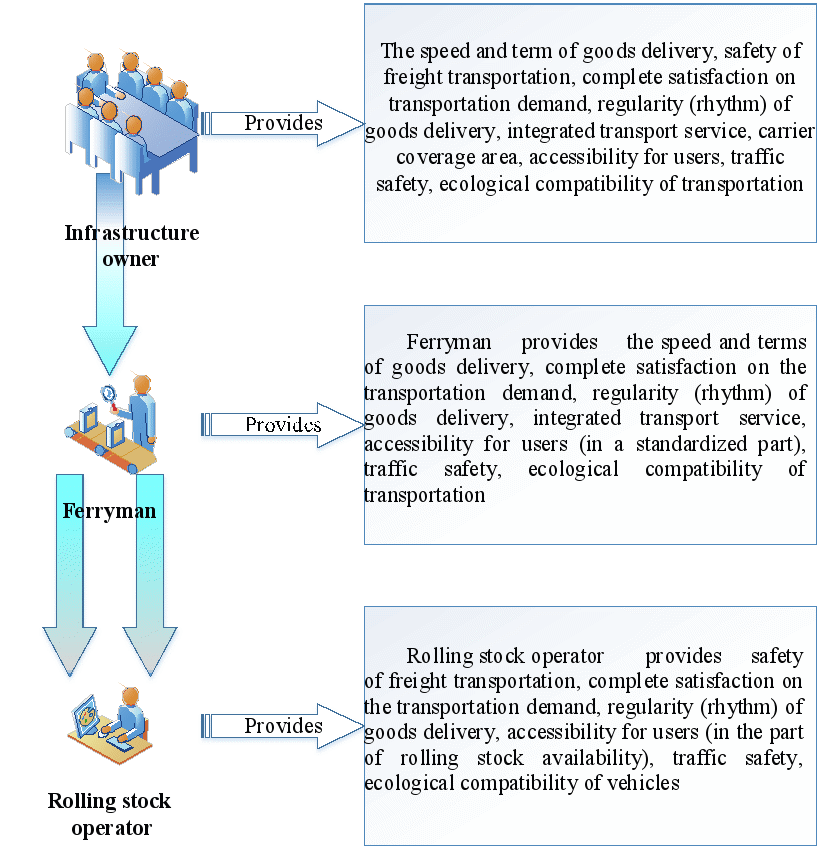
Fig. 1. Rolling stock management operator in the existent railway
system on the way of reformation.
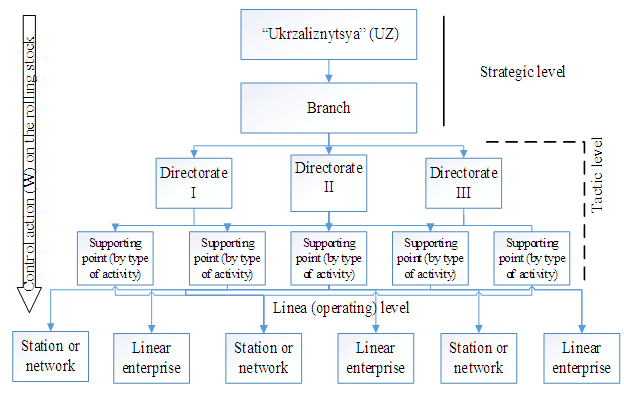
Fig. 2. Hierarchical scheme of rolling stock management levels on
the railway.
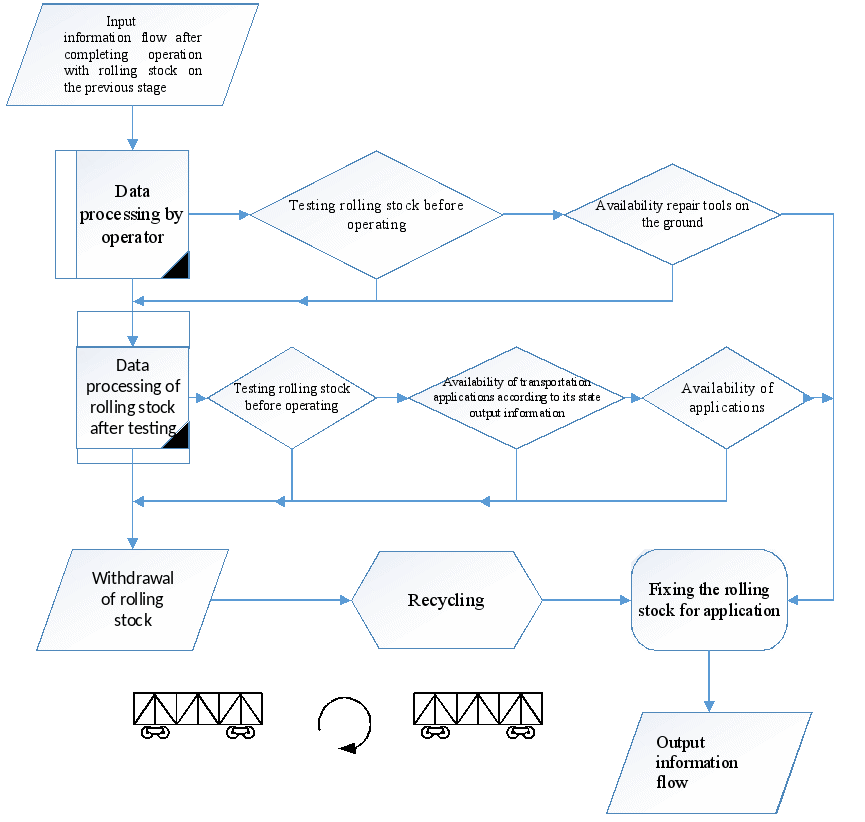
Fig. 3. Structural – logical model of the
infrastructure
operator work of
rolling stock distribution
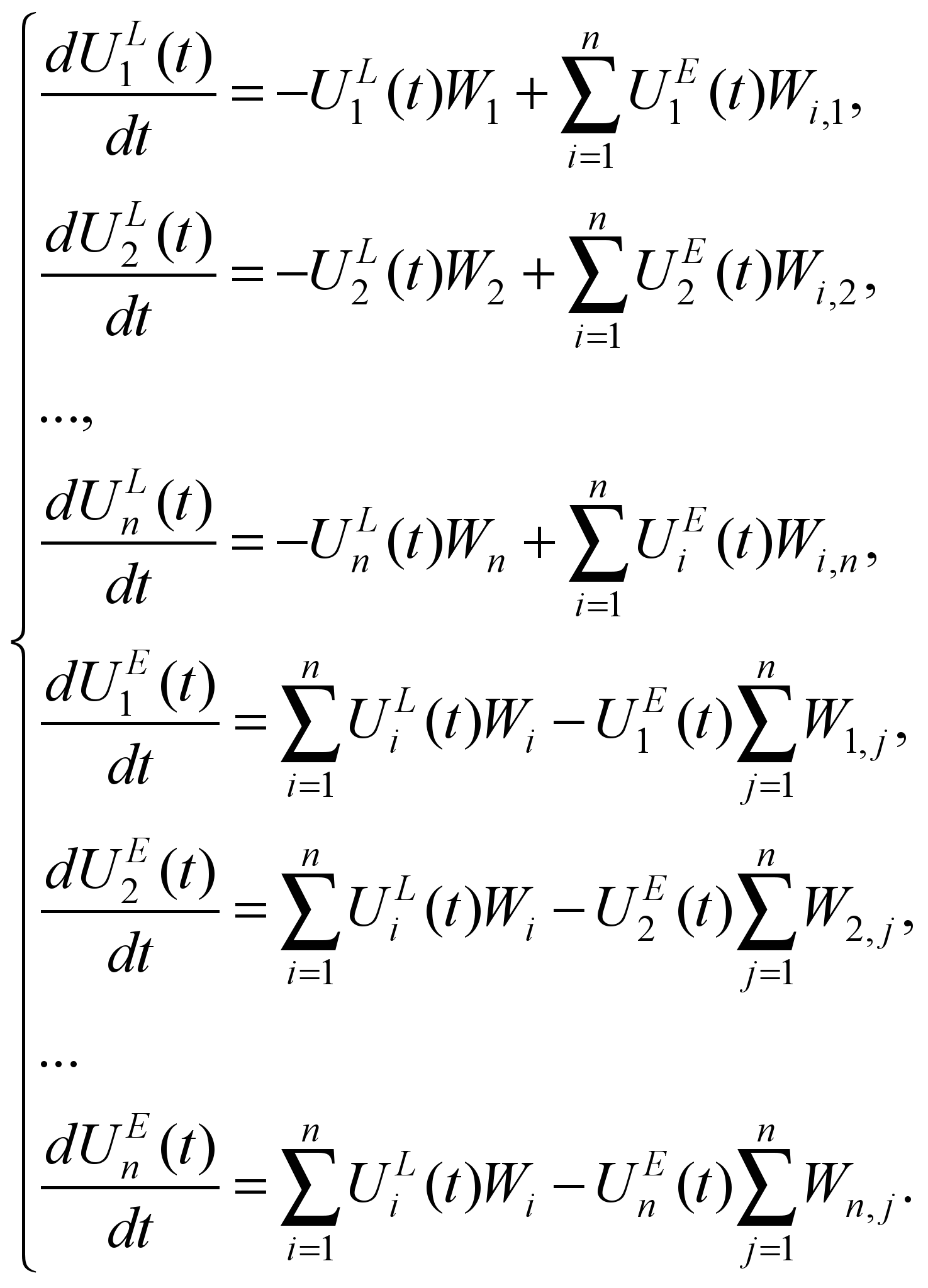 (1)
(1)
In the model (1):
 – part of
loaded cars involved in the i-th loading area, which is equal n;
– part of
loaded cars involved in the i-th loading area, which is equal n;
 – part of empty cars that can be used in the i-th loading area is
accepted that
– part of empty cars that can be used in the i-th loading area is
accepted that
 ;
;
 – probability that the empty car of the i-th loading area will be
used for loading in the loading area j in the time interval (t; t +
Δt);
– probability that the empty car of the i-th loading area will be
used for loading in the loading area j in the time interval (t; t +
Δt);
 – probability of discharging the loaded car in the loading area i,
is accepted that
– probability of discharging the loaded car in the loading area i,
is accepted that
 .
.
For
calculating the model work the conditional data are taken, Wi
parameters are hypothetical, calculations in real time scale are
connected with heavy implementation expenses and can be used without
big error.
The system (1) is linear, in
matrix form can be written U(t)=WU(t) and was shown in normal Cauchy
form. The problem of the stability simulation in providing loading
resource of railway ground is come to a range forecasting of
eigenvalues in W matrix. An important task of the system is that the
railway ground saved not only resistance of some of its state as a
whole and will have stable operation at the variation of parameters,
which consists of the following:
– type of freight and its
transportation requirements;
– car specifications, such as
type, carrying capacity, design features, etc. ;
– technological requirements
for loading;
– economic component as the
primary goal of customer and owner of rolling stock.
For calculating the model work
the conditional data are taken, W parameters are hypothetical,
calculations in real time scale are connected with heavy
implementation expenses and can be used without big error.
 , (2)
, (2)
where
 – vector constraint requirements for a car.
– vector constraint requirements for a car.
One of the most important
examples of the restriction on space 1520 mm is the index of
throughput and estimated capacity.
The states matrix is:
 (3)
(3)
Table
1
Tabulating
general given data for subsequent
calculations in evident
comparison.
|
Directorate
on the conventional ground
|
Distribution
of rolling stock in the first variant
|
Distribution
of rolling stock in the second variant
|
|

|
1/3
|
1/2
|
|

|
1/3
|
3/10
|
|

|
1/3
|
1/5
|
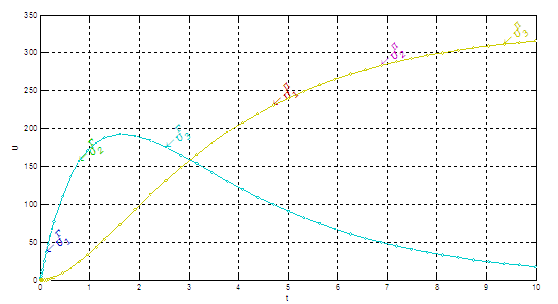
Fig. 4. The simulation results for conventional
ground П and
three equal- weighted directions ( )
)
If using
cars on each direction is not equal for rolling stock operator,
the first conventional direction has the highest priority, the third
one has – the least priority (i.e is approved
 ),
even through the day from the starting the
cars distribution actions (Figure
5) the
system will not come to a steady
state (the state of the gondola distribution comes to a relatively
steady state only in 30 hours.).
),
even through the day from the starting the
cars distribution actions (Figure
5) the
system will not come to a steady
state (the state of the gondola distribution comes to a relatively
steady state only in 30 hours.).
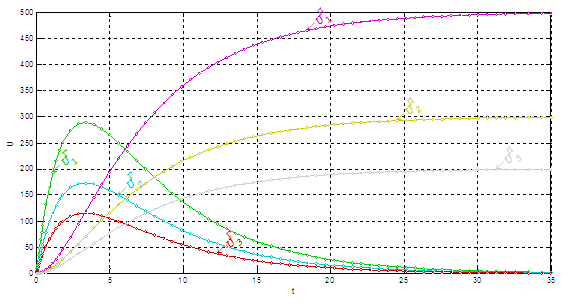
Fig. 5. The
simulation results for the conventional ground П and three
directions
with different weight characteristics ( )
)
It points out to the necessity
to consider the uniformity while reallocating rolling stock along
the ground in terms of non-discriminatory access to their
infrastructure.
Originality and Practical
value
Thus, the model allows conclude
about the ability to manage some parameters over time that is it
will characterize the process stability to ensure railway ground by
the loading resource. Further development of the model may be
carried out by taking into account the interchangeability of rolling
stock and its state.
The task set solve owing to the
modern methods of statistics and mathematical simulation. The
analysis of methods and facilities, which use by the author of the
thesis work for solving the set task, afford ground for the
conclusion as for the authenticity of results, received in the
researches. It can be confirmed by the representativeness of the
statistical material selection, considerable amount of grounds
researches and carrying out the verification model test for adequacy
and accuracy according to the known criteria.
This result used as a basis to
ground the distribution of financial effect in terms of improving
quality. Model of decision support system for optimal distribution
of rolling stock in the transportation process shown in Figure 6.
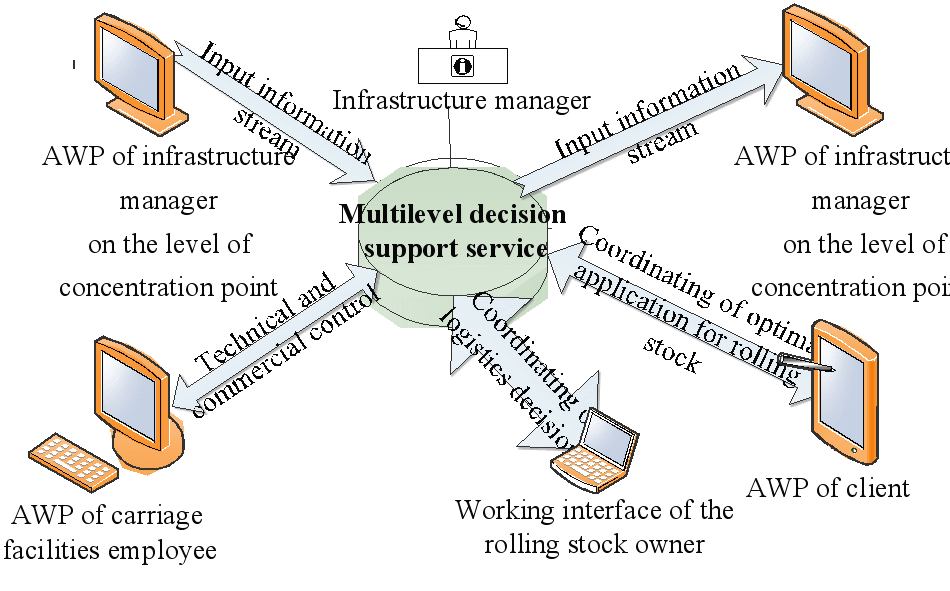
Fig. 6. Model
of decision support system for optimal distribution of rolling
stock.
Conclusions
The offered logistic model, in
terms that formed towards restructuring the rail transport, allows
developing optimal technology work of the concentration point with
rational use of rolling stock and the work of locomotive with all
transport network requirements. Using the offered models allows
infrastructure operator to reduce operating costs while managing (W)
rolling stock, to reduce local car circulation and as a result, the
period of delivery. The offered approach is its use in the
intellectual control system of optimal distribution of rolling
stock. The model allows us to predict rolling stock location by the
type and stat in each period of time that will significantly
increase the rate of useful work on the railway ground.
Conclusions, methods and
practical recommendations are collect personally by the author at
the direct analysis of the work of the Railway Transport
Directorate. The authors developed the main functions of the
automated workplace, improved the model for the distribution of
rolling stock using the method of dynamics of averages, taking into
account the condition of the car, identified the basic conditions
for forming new approach to the management of rolling stock among
which the creation of a competitive market of grain cargoes
transportation.
LIST OF REFERENCE LINKS
Данько,
Н. И. Разработка
организационно-технологической модели
управления парком грузовых вагонов
разной формы собственности
/ Н. И. Данько, Д.
В. Ломотько, В.
В. Кулешов // Инновационный
транспорт. –
2012. – №
4. – С.
8–13.
Ломотько,
Д. В.
Формування нечіткої
системи підтримки прийняття рішення
щодо придатності у комерційному
відношенні рухомого складу при його
розподілі / Д.
В. Ломотько, А. О. Ковальов,
О. В.
Ковальова // Схід.-Європ.
журнал передових технологій. – 2015. –
Т. 6, № 3
(78). – С. 11–17.
doi:
10.15587/1729-4061.2015.54496
Проект Закону про залізничний
транспорт України від 17.11.2017 р.
№ 7316
[Electronic resource]
/ Верховна Рада України.
– Available
at:
http://w1.c1.rada.gov.ua/pls/zweb2/webproc4_1?id=&pf3511=62929
– Title from
the screen. –
Accessed : 06.03.2018.
Удосконалення технології
організації вагонопотоків шляхом
формування автоматизованої системи
розрахунку і забезпечення виконання
плану формування поїздів /
С. В. Панченко, Т. В. Бутько,
В.
М. Прохоров, Л. О. Пархоменко //
Вісн.
Східноукр.
нац. ун-ту
ім. В.
Даля. – 2017. – № 3. – С. 136–142.
Bielecki, M. Total logistics management concept and principles in
manufacturing enterprise / M. Bielecki,
B. Galinska // Business
Logistics in Modern Management : 17-th
Іntern. Sci. Сonf.
(Oct. 12–13,
2017, Osijek, Croatia).
– Osijek, 2017.
– P. 93–107.
Hao, C. Optimization on Combination of Transport Routes and Modes
on Dynamic Programming for a Container Multimodal Transport System
/ C. Hao,
Y. Yue // Procedia Engineering. – 2016. – Vol. 137. –
P. 382–390. doi:
10.1016/j.proeng.2016.01.272
How planners’ use and non-use of expert knowledge affect the goal
achievement potential of plans: Experiences from strategic land-use
and transport planning processes in three Scandinavian cities / A.
Tennøy, L. Hansson, E. Lissandrello, P. Næss // Progress
in Planning. – 2016. – Vol. 109. – P. 1–32.
doi:
10.1016/j.progress.2015.05.002
Jarašūnienė, A. Analysis of Application Management Theories and
Methods for Developing Railway Transport / A.
Jarašūnienė, G.
Sinkevičius, A.
Mikalauskaitė //
Procedia Engineering. – 2017. – Vol. 187. –
P. 173–184. doi:
10.1016/j.proeng.2017.04.363
Kozachenko, D. M. Creation of export-oriented network of grain
elevators in Ukraine / D. M. Kozachenko,
R.
V. Vernigora, R. S. Rustamov // Наука та прогрес
транспорту. – 2017. – № 2 (68). – С. 56–70.
doi: 10.15802/stp2017/99952
Lomotko, D. V. Methodological Aspect of the Logistics Technologies
Formation in Reforming Processes on the Railways / D. V. Lomotko,
E. S. Alyoshinsky, G. G. Zambrybor // Transportation Research
Procedia. – 2016. – Vol. 14. – P. 2762–2766. doi:
10.1016/j.trpro.2016.05.482
Nikitinas, V. The Models of Management of Railway Companies in the
European Union: Holding, the German Experience / V. Nikitinas, S.
Dailydka // Procedia Engineering. – 2016. – Vol. 134. –
P. 80–88.
doi:
10.1016/j.proeng.2016.01.042
Scheduling preventive railway maintenance activities with resource
constraints / R. Macedo,
R. Benmansour, A. Artiba [et al.] // Electronic Notes in
Discrete Mathematics. – 2017. – Vol. 58. – P. 215–222.
doi: 10.1016/j.endm.2017.03.028
Štefancová, V. Connection of Dynamic Quality Modeling and Total
Service Management in Railway Transport Operation / V. Štefancová,
E. Nedeliaková, C. López-Escolano // Procedia Engineering. –
2017. – Vol. 192. – P. 834–839. doi:
10.1016/j.proeng.2017.06.144
The Impact of Human Resource Management on the Competitiveness of
Transport Companies / N.
Batarlienė, K. Čižiūnienė, K. Vaičiūtė [et al.] //
Procedia Engineering. – 2017. – Iss. 187. – P. 110–116.
doi: 10.1016/j.proeng.2017.04.356
Záhumenská, Z. Supporting the Connection the Logistics Centers to
Rail Network / Z. Záhumenská,
J.
Gašparík // Procedia Engineering. – 2017. – Vol. 192.
– P. 976–981. doi: 10.1016/j.proeng.2017.06.168
Д. В. Ломотько1*, Д. В.
Арсененко2, Н. А. НОСКО3, O.
В. ковальова4
1*Каф.
«Транспортні системи та логістика»,
Український державний університет
залізничного транспорту,
пл.
Фейєрбаха, 7, Харків, Україна, 61050, тел.
+38 (057) 730 19 55, ел. пошта den@kart.edu.ua,
ORCID
0000-0002-7624-2925
2Каф. «Транспортні
системи та логістика», Український
державний університет залізничного
транспорту,
пл. Фейєрбаха, 7, Харків,
Україна, 61050, тел. +38 (057) 730 19 55, ел. пошта
TSL@kart.edu.ua,
ORCID
0000-0001-7757-8706
3Каф. «Транспортні системи та
логістика», Український державний
університет залізничного транспорту,
пл. Фейєрбаха, 7, Харків, Україна., 61050,
тел. +38 (057) 730 19 55, ел. пошта TSL@kart.edu.ua,
ORCID 0000-0002-4741-5890
4Каф. «Управління вантажною та
комерційною роботою», Український
державний університет
залізничного
транспорту, пл. Фейєрбаха, 7, Харків,
Україна, 61050, тел. +38 (057) 730 10 85,
ел. пошта
kovalova.uvkr@kart.edu.ua,
ORCID 0000-0001-5342-0795
ФОРМАЛІЗАЦІЯ ПРОЦЕСУ РОЗПОДІЛУ
РУХОМОГО
СКЛАДУ З ВИКОРИСТАННЯМ
ДИНАМІЧНОЇ МОДЕЛІ
Мета. Стаття
спрямована на формалізацію процесу
підвищення ефективності розподілу
рухомого складу на залізницях під
завантаження шляхом концентрації
навантажувальних робіт на терміналах
за допомогою динамічної моделі. Методика.
Як показує досвід, для оператора
інфраструктури розподіл рухомого
складу є складним процесом. У роботі
проаналізовано транспортно-експедиційне
обслуговування, технологію роботи
окремих суб’єктів залізничної галузі
й формування організаційних принципів
керування вагонами підприємств різних
форм власності. Установлено, що система
розподілу рухомого складу, заснована
на принципах логістичного контролю на
шляху прямування, повинна відповідати
наступним методологічним критеріям:
скорочення часу пропуску й очікування
вантажних операцій, формування
достовірного інформаційного середовища
для всіх учасників транспортування,
створення умов для прийняття швидкого
й максимально вигідного рішення щодо
подальшого руху рухомого складу.
Результати.
Створено перелік необхідних умов для
динамічного розвитку транспортного
сектора відповідно до поточних вимог
ринку. Розглянуто алгоритм логістичного
управління процесом розподілу
залізничного рухомого складу. Доведено,
що відносини між учасниками транспортного
процесу на початкових етапах реформ
формуються на основі недискримінаційного
доступу до ресурсів вантажів. Наукова
новизна. Проаналізована
робота диспетчерського персоналу з
точки зору попиту на рухомий склад на
всіх етапах управління транспортним
процесом. Уперше запропонована динамічна
модель, яка відтворює інформаційне
поле для всіх учасників переміщення
рухомого складу. За її допомогою
встановлено, що залізниці повинні
створювати систему розподілу рухомого
складу, яка має відповідати наступним
критеріям: зменшення пробігу й тривалості
очікування вантажних операцій, створення
умов прийняття швидкого й вигідного
рішення щодо подальшого просування
рухомого складу. Практична
значимість. Застосування
розробленого методу розподілу рухомого
складу для формування одиничних поїздів
дозволить значно зменшити логістичні
витрати в ланцюгу постачання й
підвищити його конкурентоспроможність
на зовнішньому ринку. Розвиток такої
системи покликаний створити справді
незалежний регулятор транспортно-логістичного
процесу в умовах формування єдиного
інформаційного середовища.
Ключові слова: логістична технологія;
рухомий склад; залізничний транспорт;
управління залізницею; динамічна модель
розподілу ресурсів
Д. В. Ломотько1*, Д. В.
Арсененко2, Н. А. НОСКО3, O.
В. ковалева4
1*Каф.
«Транспортные системы и логистика»,
Украинский государственный университет
железнодорожного транспорта, пл.
Фейербаха, 7, Харьков, Украина, 61050,
тел.
+38 (057) 730 19 55, эл. почта den@kart.edu.ua,
ORCID
0000-0002-7624-2925
2Каф. «Транспортные
системы и логистика», Украинский
государственный университет
железнодорожного транспорта, пл.
Фейербаха, 7, Харьков, Украина, 61050,
тел.
+38 (057) 730 19 55, эл. почта TSL@kart.edu.ua,
ORCID
0000-0001-7757-8706
3Каф. «Транспортные
системы и логистика», Украинский
государственный университет
железнодорожного транспорта, пл.
Фейербаха, 7, Харьков, Украина, 61050,
тел.
+38 (057) 730 19 55+38 (057) 730 19 55, эл. почта
TSL@kart.edu.ua,
ORCID 0000-0002-4741-5890
4Каф.
«Управление грузовой и коммерческой
работой», Украинский государственный
университет железнодорожного транспорта,
пл. Фейербаха, 7, Харьков, Украина, 61050,
тел. +38 (057) 730 10 85, эл. почта
kovalova.uvkr@kart.edu.ua,
ORCID 0000-0001-5342-0795
Формализация процесса
распределения
подвижного
состава с использованием
динамических
моделей
Цель. Статья
предполагает формализацию процесса
повышения эффективности распределения
подвижного состава на железных дорогах
под погрузку путем концентрации
погрузочных работ на терминалах с
помощью динамической модели. Методика.
Как показывает опыт, для оператора
инфраструктуры распределение подвижного
состава является сложным процессом. В
работе проанализировано
транспортно-экспедиционное обслуживание,
технология работы отдельных субъектов
железнодорожной отрасли и формирование
организационных принципов управления
вагонами предприятий различных форм
собственности. Установлено, что система
распределения подвижного состава,
основанная на принципах логистического
контроля в пути следования, должна
отвечать следующим методологическим
критериям: сокращение времени пропуска
и ожидания грузовых операций, формирование
достоверной информационной среды для
всех участников транспортировки,
создание условий для принятия быстрого
и максимально выгодного решения по
дальнейшему продвижению подвижного
состава. Результаты.
Создан перечень необходимых условий
для динамического развития транспортного
сектора в соответствия с современными
требованиями рынка. Рассмотрен алгоритм
логистического управления процессом
распределения железнодорожного
подвижного состава. Доказано, что
отношения между участниками транспортного
процесса в начальных условиях реформ
строятся на основе недискриминационного
доступа к ресурсам грузов. Научная
новизна. Проанализирована
работа диспетчерского персонала с
точки зрения спроса на подвижной состав
на всех этапах управления транспортным
процессом. Впервые предложена динамическая
модель, которая воспроизводит
информационное пространство для всех
участников перемещения подвижного
состава. С ее помощью установлено, что
железные дороги должны создавать
систему распределения подвижного
состава, соответствующую следующим
критериям: уменьшение пробега и времени
ожидания грузовых операций, создание
условий для принятия быстрого и выгодного
решения по дальнейшему продвижению
подвижного состава. Практическая
значимость. Применение
разработанного метода распределения
подвижного состава для формирования
одиночных поездов позволит значительно
уменьшить логистические затраты в
цепочке поставок и повысить его
конкурентоспособность на внешнем
рынке. Развитие такой системы призвано
создать действительно независимый
регулятор транспортно-логистического
процесса в условиях формирования единой
информационной среды.
Ключевые слова: логистическая
технология; подвижной состав;
железнодорожный транспорт; управление
железной дорогой; динамическая модель
распределения ресурсов
REFERENCES
Danko, N. I., Lomotko,
D. V.,
Kuleshov, V. V.
(2012). Developing an organizational technologic model for
management of freight car fleet of various ownership forms.
Innotrans, 4, 8-13.
(in
Russian)
Lomotko, D. V., Kovalov, A. O., & Kovalova,
O. V. (2015). Formation of fuzzy support system for decision-making
on merchantability of rolling stock in its allocation.
Eastern-European Journal of Enterprise Technologies, 6(3(78),
11-17. doi: 10.15587/1729-4061.2015.54496 (in
Ukrainian)
Proekt Zakonu pro zaliznychnyi transport Ukrainy.
Verkhovna Rada Ukrainy.
Retrieved from
http://w1.c1.rada.gov.ua/pls/zweb2/webproc4_1?id=&pf3511=62929
(in Ukrainian)
Panchenko, S. V., Butko, T. V., Prohorov, V. M., & Parhomenko,
L. O. (2017). Udoskonalennia tekhnolohii orhanizatsii vahonopotokiv
shliakhom formuvannia avtomatyzovanoi systemy rozrakhunku i
zabezpechennia vykonannia planu formuvannia poizdiv. Visnik
of the Volodymyr Dahl East Ukrainian National University, 3,
136-142. (in Ukrainian)
Bielecki, M., & Galinska, B. (2017).
Total logistics management concept and principles in manufacturing
enterprise. Business Logistics in Modern Management:
17-th international scientific conference (October
2017, Osijek, Croatia),
93-107. (in English)
Hao, C.,
& Yue, Y. (2016). Optimization on Combination of
Transport Routes and Modes on Dynamic Programming for a Container
Multimodal Transport System. Procedia
Engineering, 137, 382-390.
doi:
10.1016/j.proeng.2016.01.272
(in English)
Tennøy, A., Hansson, L.,
Lissandrello, E.,
& Næss, P. (2016). How planners’ use and non-use of
expert knowledge affect the goal achievement potential of plans:
Experiences from strategic land-use and transport planning
processes in three Scandinavian cities.
Progress in Planning, 109, 1-32.
doi:
10.1016/j.progress.2015.05.002
(in English)
Jarašūnienė, A., Sinkevičius, G., &
Mikalauskaitė, A. (2017). Analysis of Application Management
Theories and Methods for Developing Railway Transport. Procedia
Engineering, 187, 173-184.
doi:
10.1016/j.proeng.2017.04.363
(in English)
Kozachenko, D. M., Vernigora, R. V., &
Rustamov, R. S. (2017). Creation of export-oriented network of
grain elevators in Ukraine. Science and
Transport Progress, 2(68), 56-70.
doi: 10.15802/stp2017/99952 (in English)
Lomotko, D. V., Alyoshinsky, E. S., &
Zambrybor, G. G. (2016). Metodologikal Aspekt of the Logistics
Tehnologies Formation in Reforming on the Railways. Transportation
Research Procedia, 14, 2762-2766.
doi:
10.1016/j.trpro.2016.05.482 (in English)
Nikitinas, V., & Dailydka, S.
(2016). The Models of Management of Railway Companies in the
European Union: Holding, the German Experience. Procedia
Engineering, 134, 80-88.
doi:
10.1016/j.proeng.2016.01.042
(in English)
Macedo,
R., Benmansour, R., Artiba, A., Mladenović, N.,
& Urošević, D. (2017). Scheduling preventive railway
maintenance activities with resource constraints. Electronic
Notes in Discrete Mathematics, 58, 215-222. doi:
10.1016/j.endm.2017.03.028
(in English)
Štefancová, V., Nedeliaková, E., & López-Escolano, C.
(2016). Connection of Dynamic Quality Modeling and Total Service
Management in Railway Transport Operation. Procedia
Engineering, 192, 834-839.
doi:
10.1016/j.proeng.2017.06.144
(in English)
Batarlienė,
N., Čižiūnienė, K., Vaičiūtė, K., Šapalaitė, I., &
Jarašūnienė, A. (2017). The Impact of Human
Resource Management on the Competitiveness of Transport Companies.
Procedia Engineering, 187,
110-116. doi: 10.1016/j.proeng.2017.04.356
(in English)
Záhumenská, Z., & Gašparík,
J. (2017). Supporting the Connection the Logistics Centers
to Rail Network. Procedia Engineering, 192,
976-981. doi: 10.1016/j.proeng.2017.06.168
(in English)
Received:
July 30,
2018
Accepted:
Nov. 14, 2018